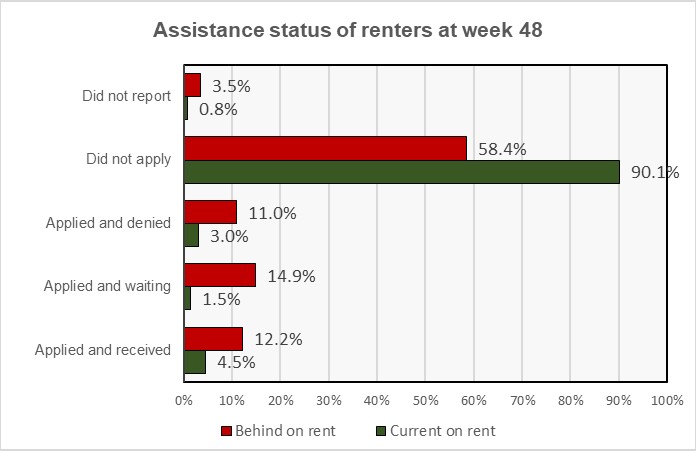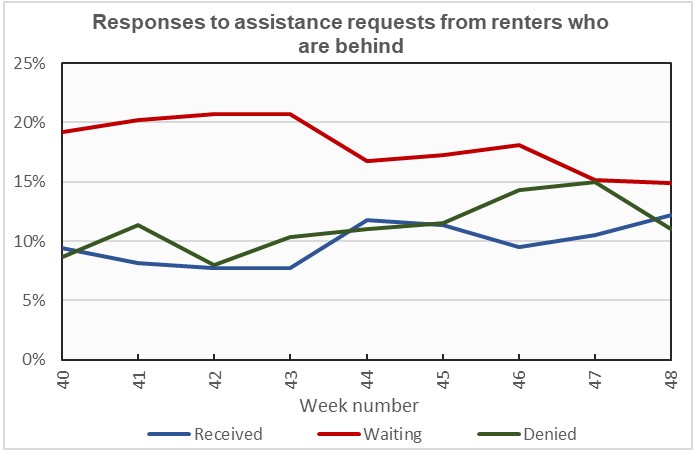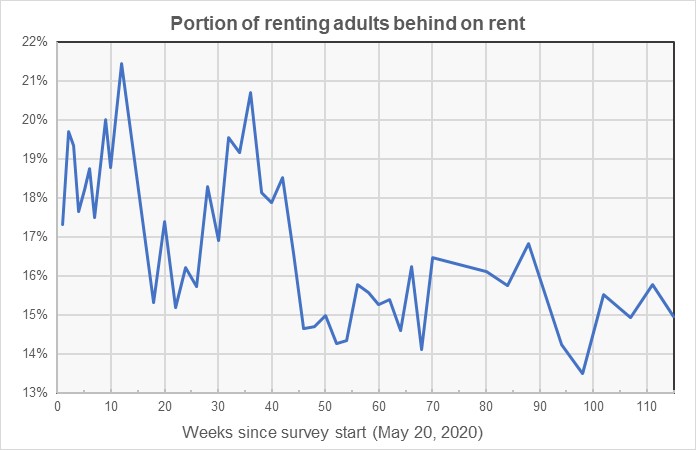The “Week 48” edition of the Census Bureau’s Pulse Survey shows that the portion of renter who are behind on their rent payments has stabilized at around 15 percent.
What is the Pulse Survey?
The Pulse Survey is an experimental program that the Census Bureau started shortly after economic shutdowns were imposed in response to COVID-19. It was designed to assess how the population of the country was faring under the economic stress caused by the reaction to the pandemic. The current survey, designated Week 48, posed questions which are part of what Census calls Phase 3.5 of the survey.
The Week 48 survey collected data from July 27 to August 8, 2022. This is 4 weeks after the period in which the “Week 47” survey data was collected. The renter portion of the survey covers renters of both multifamily and of single-family properties.
Seeking help
A new question introduced in the “Week 40” survey in early December 2021 asked whether the respondent had sought government assistance in paying their rent. The first chart shows the assistance status of those who were behind on their rent and of those who were current on their rent in the “Week 48” survey.

The chart shows that less than 10 percent of renters who are current on their rent applied for assistance. In addition, only 38 percent of those who are behind on their rent applied for rental assistance. It is possible that many of those who chose not to apply realized that they did not qualify under the available programs. Of the people who are behind and applied for rental assistance, 29 percent were denied while 32 percent have received assistance thus far.
The survey reported that 12.2 percent of renters who are behind on their rent received rental assistance but are still behind. It also said that 4.5 percent of those who are current on their rent reported having received assistance. However, in absolute numbers rather than relative percentages, those who received assistance and are current outnumber those who received assistance and are still behind by 2 to 1.
The next chart shows the history of how those who are behind on their rent said that their requests for assistance were resolved. As one might expect, over time the portions of those saying that they were either given or denied assistance would rise while the portion of those who are waiting for assistance would decline. However, the anomaly in the latest data set is that the portion of applicants who reported being declined assistance fell. This may just reflect the natural variability in the data due to its limited sample size.

The Pulse Survey identified a little over 3.2 million adults who have received emergency rental assistance. This is down from the number reported in the last Pulse survey.
Record rent growth?
The survey asked participants whether they had experienced rent increases over the past 12 months. The results are given in the next chart, below, which shows the portion of renters answering this question for each of 6 possible rent growth levels. Census asked the question about rent growth in dollars rather than as a percentage of current rent, so the results are not directly comparable to those reported elsewhere.

Given reports of record rent growth from sources like Apartment List and Yardi Matrix, it is surprising that Census found that over 46 percent of renters either saw no rent increase or saw their rent go down in the prior 12 months. However, this result is in line with that found in the quarterly housing survey from the Census Bureau, which attempts to cover all rental properties, not just larger, professionally managed properties which are the focus of industry surveys.
Tracking delinquency rates
Renters in all phases of the survey have been asked whether they are behind on their rent. While some say that they occupy their housing without paying rent and some did not report whether they are current on their payments, the majority of respondents answered the question Yes or No. The next chart, below, shows the history of responses to this question. Note that the midpoint of the “Week 48” survey period was August 2, 115 weeks after the initial Pulse Survey.

The survey is conducted over a two-week period which lately has spanned the end of one month and the start of the next. Since rent is normally due on the first, a renter who was current on his rent at the start of the survey period may find himself behind if asked the question a few days later. This may explain some of the variation in the responses to this question.
Given that the economy has largely stabilized after the pandemic and that unemployment is again low, the portion of renters who are behind on their rent early in the month may just be the “normal” level.
Profiling the participants
Of the respondents who reported being current on their rent, 35 percent said that they had children in the household. Of those reporting being behind on their rent, 58 percent reported having children in the household.
Of the respondents who reported being current on their rent, 15 percent said that they or a household member had experienced a loss of employment income over the prior 4 weeks. Of those reporting being behind on their rent, 42 percent reported that they or a household member had experienced a loss of employment income.
The final chart shows the sources of the funds survey respondents used to meet spending needs. Many of the differences between the people who are current on their rent and those who are behind are as one would expect: the former are more likely to rely on regular sources of income while the latter are more likely to rely on borrowing and on government assistance.














